The Athletic has been attending some of the most ferocious derbies across Europe, charting the history of the continent’s most deep-rooted and volatile footballing rivalries.
The series began last season, covering 10 combustible fixtures from Athens to Anfield. We attended De Klassieker and the Derby della Capitale, the Eternal Derby and the Old Firm. We then resumed our journey this season by taking in games in Copenhagen, Salzburg, Lisbon and Belfast.
We were in Ipswich and Zagreb in December, then Sunderland and the Black Country, and watched Sparta play Slavia in Prague. We were in Poland for the Great Silesian derby and, last month, branched further afield to cover the Clasico Regiomontano.
Now to Dublin, a city of derbies, and Bohemians’ meeting with Shamrock Rovers…
It began in a pyrotechnic fog and ended in a brief 22-player and staff rumble.
There was a goal each and a point each. There were some lusty challenges, give-and-take football — “basketball” said one of the managers. There was noise, colour, occasional barbed chants from the sell-out crowd and a green banner reading, ‘My Town, My Heart’.
True, there was no pig’s head, as there has been at Dalymount Park, and no urine either. But the 285th ‘Dublin derby’ (249th in the League of Ireland) — Bohemians versus Shamrock Rovers — contained the essence of a rivalry that started in 1915 and which, in the context of a reinvigorated League of Ireland, matters as much today as it has done in any of its 109 years.
The Dublin Derby in full swing (Brendan Moran/Sportsfile via Getty Images)
Bohemians, from inner north Dublin, were formed in 1890 and are the Irish capital’s oldest soccer club — ‘Dublin’s Originals’ as it says on their training kit crest. They are known as ‘Bohs’.
Shamrock Rovers, from inner south Dublin in the beginning, were formed in 1901, are statistically the most successful club in League of Ireland history and claim to be the biggest club in the country. It’s a reasonable claim.
In between these two clubs flows the River Liffey and it is this Northside-Southside geography, plus early successes, which birthed the Bohs-Rovers rivalry. Although there have been many Rovers changes since 1915 — and they have staged home games, seasons even, at Bohemians’ Dalymount — their ground since 2009 has been in Tallaght, seven miles south of the big river.
Northside-Southside remains the division with trophies, drama and personal stories adding to the weight of history. There are no bolted-on grievances.
Rovers won the second League of Ireland, post-Partition, in 1922, Bohs the third, Rovers the fourth and sixth, Bohs the seventh and ninth. The rhythm was set. There are other senior Dublin clubs — Shelbourne and St Patrick’s Athletic are in the same division — and other Dublin rivalries have interrupted the Bohs-Rovers’ intensity, but it has endured in League of Ireland consciousness as the Dublin derby.
It has been a benign relationship, mainly. Pat Fenlon is Bohs’ director of football but supported Rovers as a boy. After returning from Chelsea as a teenager, Fenlon played for and managed both clubs. In a Dalymount portable cabin before kick-off last Friday night, he says: “I’ve played here when there’s been a full-scale riot on the pitch afterwards — I was playing for Bohs and we won the Cup.
“But I used to come here as a Rovers fan and both sets of supporters would swap ends. At one stage, both sets would stand under the shed at the far end. You’d have an imaginary line between them.
“This is a proper game — a proper derby game. There’s a big rivalry. It’s developed in the last 25 years and it can be a little nasty at times. It’s got a little bit toxic, tension in the air.
“It’s the game you look forward to. This matters.”

Shamrock Rovers’ manager Stephen Bradley (Stephen McCarthy/Sportsfile via Getty Images)
You could tell that from the speed and feeling in some of the tackling. Bohs went 1-0 up, a sharp finish from Polish striker Filip Piszczek, and had a couple of valid penalty claims. Rovers found an equaliser from Johnny Kenny just before half-time and dominated the second half. It was fast and physical and the final whistle brought home relief.
The 1-1 draw left Rovers second, Bohs fourth in the early table; the League of Ireland runs from February to November. It left Rovers’ manager Stephen Bradley frustrated. “It became a bit of a basketball game, which they like,” he says.
But Bradley knows he has injured players to return and a fifth consecutive Rovers league title — never done before — is a strong possibility.
Like Fenlon, Bradley is a Dubliner. Like Fenlon, he left as a teenager to go to London, in Bradley’s case to Arsenal. Without bravado, he assesses Shamrock Rovers’ present and its past and tells The Athletic: “I don’t think there’s any question that we’re the biggest team, the most successful.
“This team has just done four in a row and we’re going for five. If we do that, we make history.
“Only one other team has done four in a row: the Rovers team of the 1980s. That tells you what you need to know.”

Tempers flare at the end of last Friday’s 1-1 draw (Stephen McCarthy/Sportsfile via Getty Images)
Macdara Ferris can fairly be described as a Shamrock Rovers encyclopaedia. As an author, Ferris has written about the club; as a fan, he has put his hand in his pocket when times were tough — and Rovers have been to the brink.
As a follower, he was also at Dalymount Park for the derby in 2004 when a pig’s head and a few trotters descended onto the pitch in the direction of two Bohs’ players — Tony Grant and James Keddy — who had just crossed the divide by signing from financially-stricken Rovers. It inspired the newspaper headline: ‘Snout of Order.’
“I was not behind it,” Ferris is quick to say of the pig’s head, a nod to the Luis Figo incident at Barcelona two years earlier. (The Belfast derby has also had its pork moment). “But the photo showing the head being put out below a Shamrock Rovers flag? It was my flag.”
Ferris is laughing. “Figo?” he says, “that was a piglet’s head. This was so big!
“By all accounts, it was smuggled into Dalymount inside a drum. Grant was a fans’ favourite. He moved, but you understand why he moved: Rovers’ players weren’t being paid.”
That game came three years after an amazing derby which saw Rovers hammer Bohs 4-1 in the first half, only to lose 6-4. Then in 2010, with future Northern Ireland manager Michael O’Neill in charge of Rovers, they and Bohs took the title to the last day with Rovers clinching it on a superior goal difference of two.
That 2010 success was Rovers’ 16th League title — a record — and illustrates the club’s historic status. The total is now 21 and there have been a record 25 FAI (Football Association of Ireland) Cups. But the fact that 2010 was Rovers’ first for 16 years tells another story; one of homelessness, hardship and administration. It ended in 2005 with the famous club in court waiting to see if it could continue as a going concern.
“Rovers got relegated for the one and only time in 2005,” Ferris explains. “People talk about the stroke of a judge’s pen. Rovers could have gone out of business at that point.”
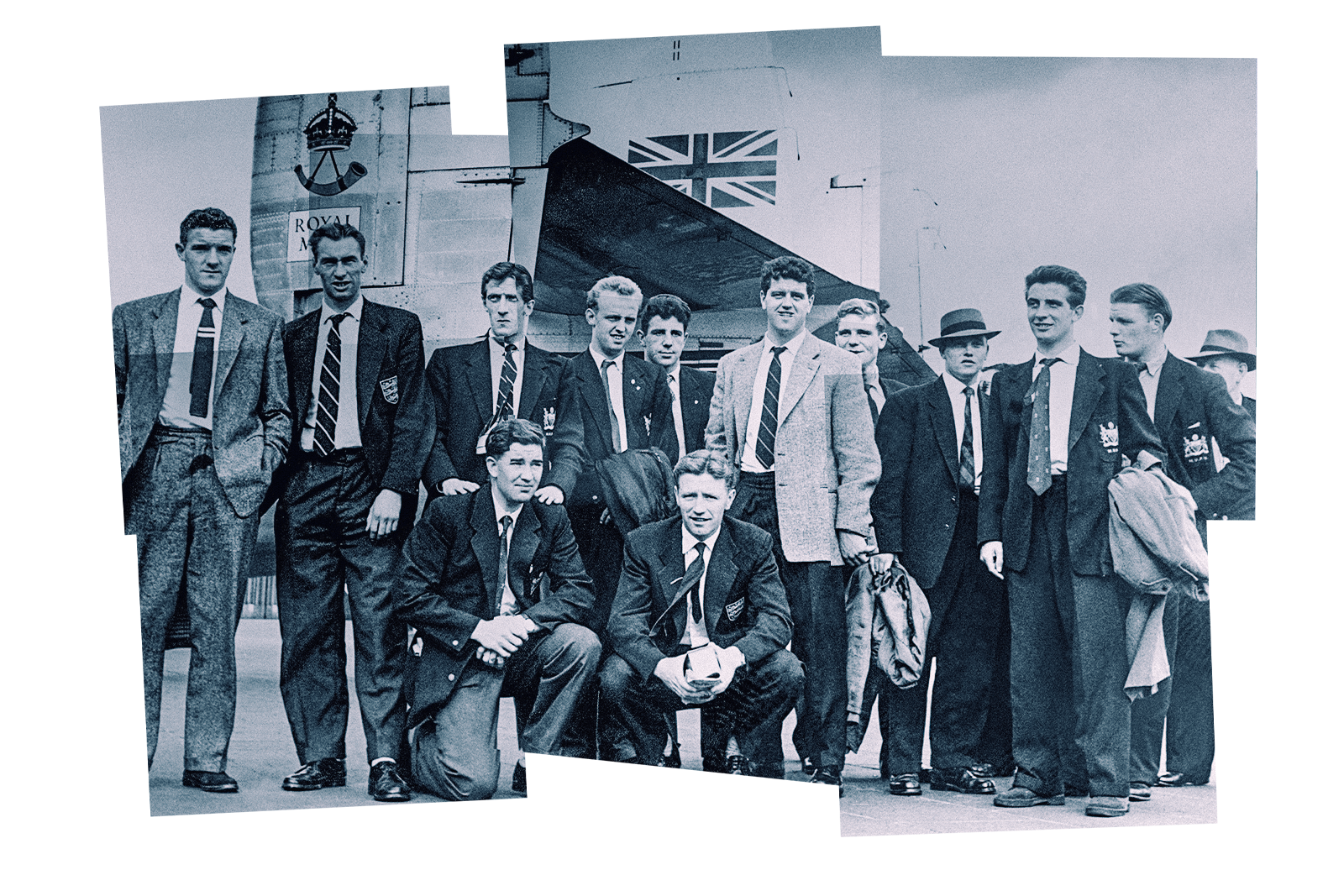
Manchester United prepare to travel to their European Cup tie against Shamrock Rovers in 1957 (S&G/PA Images via Getty Images)
Having established themselves as regular Irish champions in the 1920s and 1930s, Rovers moved up a gear in the 1950s, winning another three titles and, in 1957, entering the European Cup. They drew Manchester United — the Busby Babes — but the game was staged at Bohemians’ Dalymount due to its greater capacity. Future Rovers European games were held there because Milltown had no floodlights.
There were 45,000 there, officially. United won 6-0, with Liam Whelan, born a few hundred yards from Dalymount, scoring two. Four months later, Whelan and 22 others were killed in the Munich air crash.
“Rovers were the first League of Ireland club to play in the European Cup and they played the Busby Babes,” Ferris says. “In the 1960s, Rovers then won the Cup six years in a row and so were playing in the European Cup Winners’ Cup. They played big teams — Bayern Munich — and were 10 minutes from knocking them out. Then Gerd Muller scored. Bayern went on to win their first European trophy.
“It would probably put other clubs’ noses out of joint, but Rovers would be the marquee name in the League. Playing the Busby Babes, Bayern Munich, the green-and-white hooped jerseys and just the name ‘Shamrock Rovers’ — the name is unique.”
It originated on Shamrock Avenue, now gone, though a plaque nearby in Ringsend commemorates the club’s foundation.
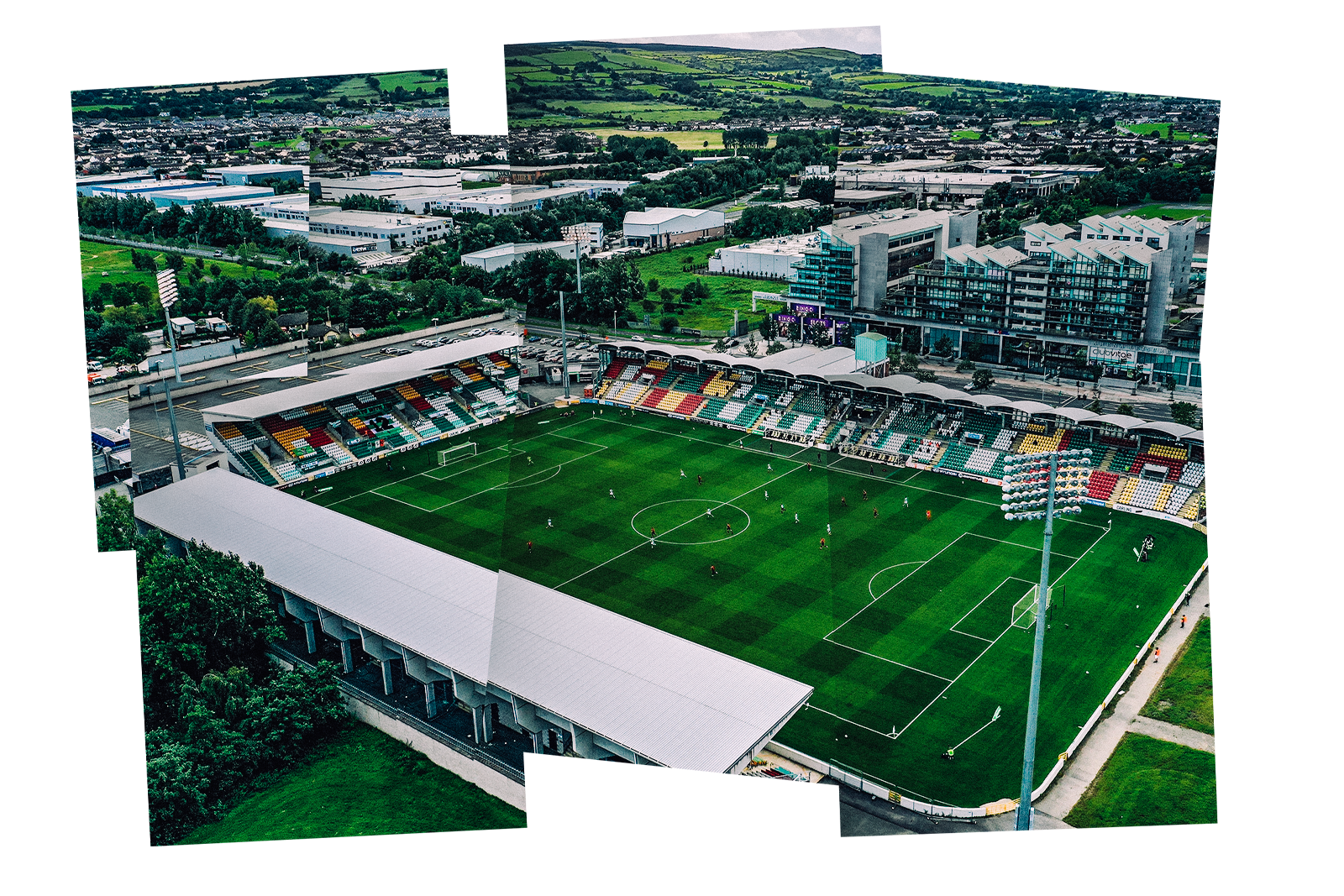
Rovers’ current home, Tallaght Stadium, opened in 2009 (Ramsey Cardy/Sportsfile via Getty Images)
“And they do draw fans from around the city,” adds Ferris. “That’s due to success but also because, after playing at Milltown, they moved around and that grew a wider base.”
‘Moved around’ is a gentle way to describe Rovers’ lack of a stadium after the controversial sale of Milltown and their departure in 1987. One of Bohemians’ nicknames is ‘The Gypsies’, but it was Rovers who were wandering around the capital for almost 20 years. From 1988-90, Dalymount Park was ‘home’, and again in 2005. Other Dublin clubs such as Shelbourne rented out their premises and, as Ferris recalls ruefully, there was even a Rovers ‘home’ game played 160 miles away in Cork.
“That was the low point,” he says. “Rovers had to use their away jersey that day.”
Ferris was one of the ‘400 Club’ group of fans who used their own money to rescue the club from oblivion. Their commitment was rewarded when the Tallaght Stadium opened in 2009, the title came a year later and then, in 2011-12, Rovers reached the Europa League group stage, meeting Tottenham.
The 400 Club still owns 50 per cent of Rovers with two benefactors, Ray Wilson and leading Celtic shareholder Dermot Desmond, owning the other 50 per cent.
“During the dark times of the 1990s and the early 2000s, when they were renting off their rivals and playing in front of crowds that dropped to about 500, the fans sang about four in a row,” Ferris says. “The only thing keeping them going was the history.
“Fast forward to 2024 and the fourth stand is in at Tallaght, the capacity is 10,500 and the game there against Bohs earlier in the season was a sell-out, the biggest League of Ireland crowd for 30 years. It’s where the women’s national team play.
“It’s still challenging economically and the club made a loss last year, though some of the debt is from Covid. It’s not as bad as it looks.
“We’re playing good football, got an academy, bringing players through. The club rent the training ground, but it’s full-time professional.”
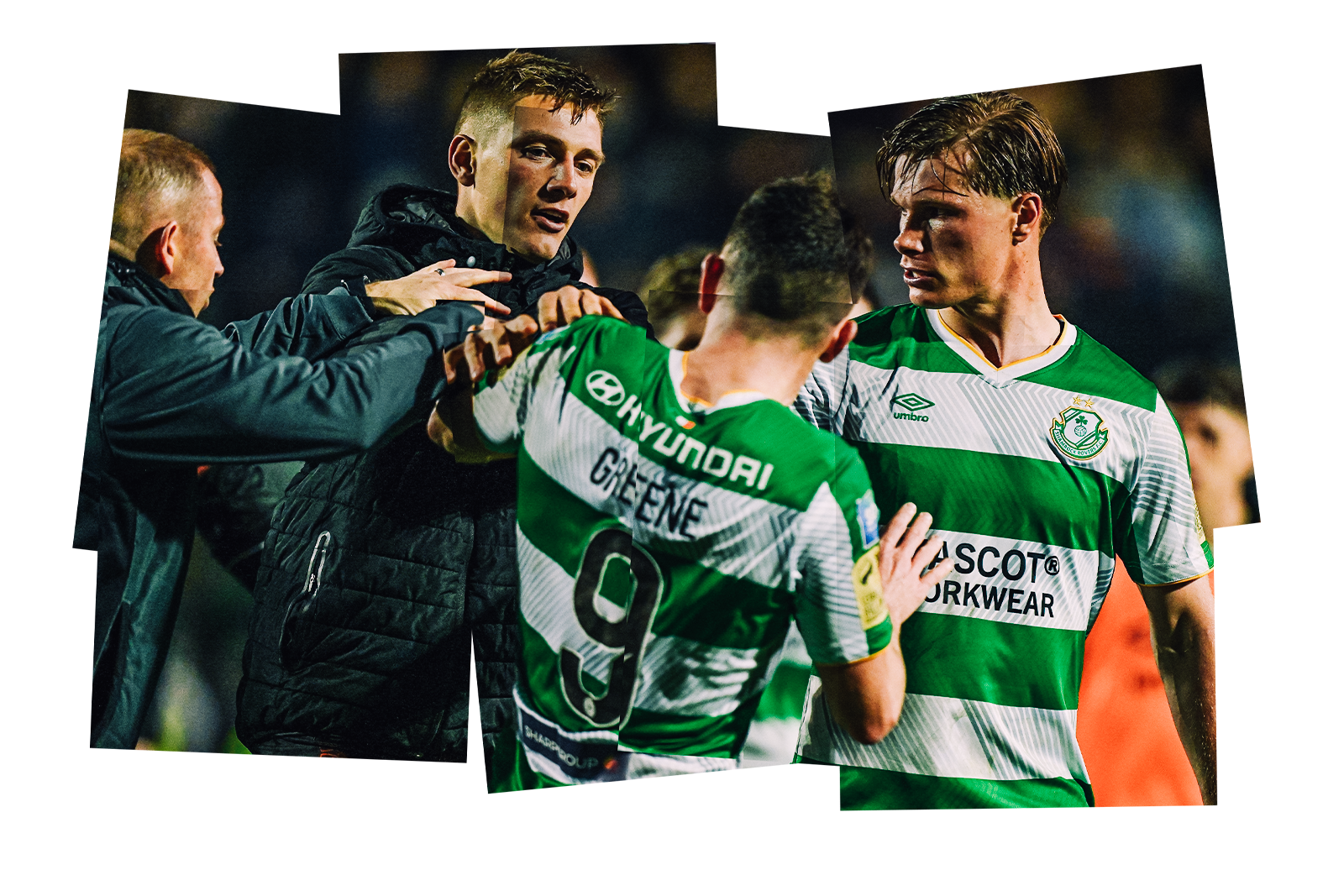
Bohs’ Piszczek clashes with Aaron Greene of Shamrock Rovers (Brendan Moran/Sportsfile via Getty Images)
In the Bohemians’ boardroom in the Phibsboro Tower, adjacent to Dalymount Park, the writing is on the wall. A mural describes how and where the club came into being in the 1890s until they found their permanent home in a place then known as ‘Pisser Dignam’s Field’.
No one knows who Pisser Dignam was, but he had at least one talent.
Historian Gerry Farrell starts with the club’s name: “Bohemians is fine, but never ‘Bohemians FC’. It’s Bohemian FC, Bohemians or Bohs.”
The other name under consideration among the young students who first met in 1890 in Phoenix Park was, funnily enough, ‘Rovers’. But Bohemians was the choice and it was to be a members’ club, Corinthian in attitude.
“At the time, the word ‘Bohemian’ was part of popular culture,” Farrell says. “There was the Bohemian Balfe Opera, there were romantic notions of Bohemia as a place where people were free-living. If you look at those young men, they have quite diverse interests, so Bohemian suits their outlook.
“And Bohs were strictly amateur. It was their ethos, playing for the sake of pleasure. It remained that way until 1969.”
Ireland had one league, the Belfast-based Irish League. Bohs joined it in 1902 and won the Irish Cup in 1908. After Irish independence, Bohs joined the League of Ireland, which they have won 11 times, the last in 2009. It has not been glory upon glory and, as Farrell says of the 1969 decision: “You can only be an amateur club for so long.
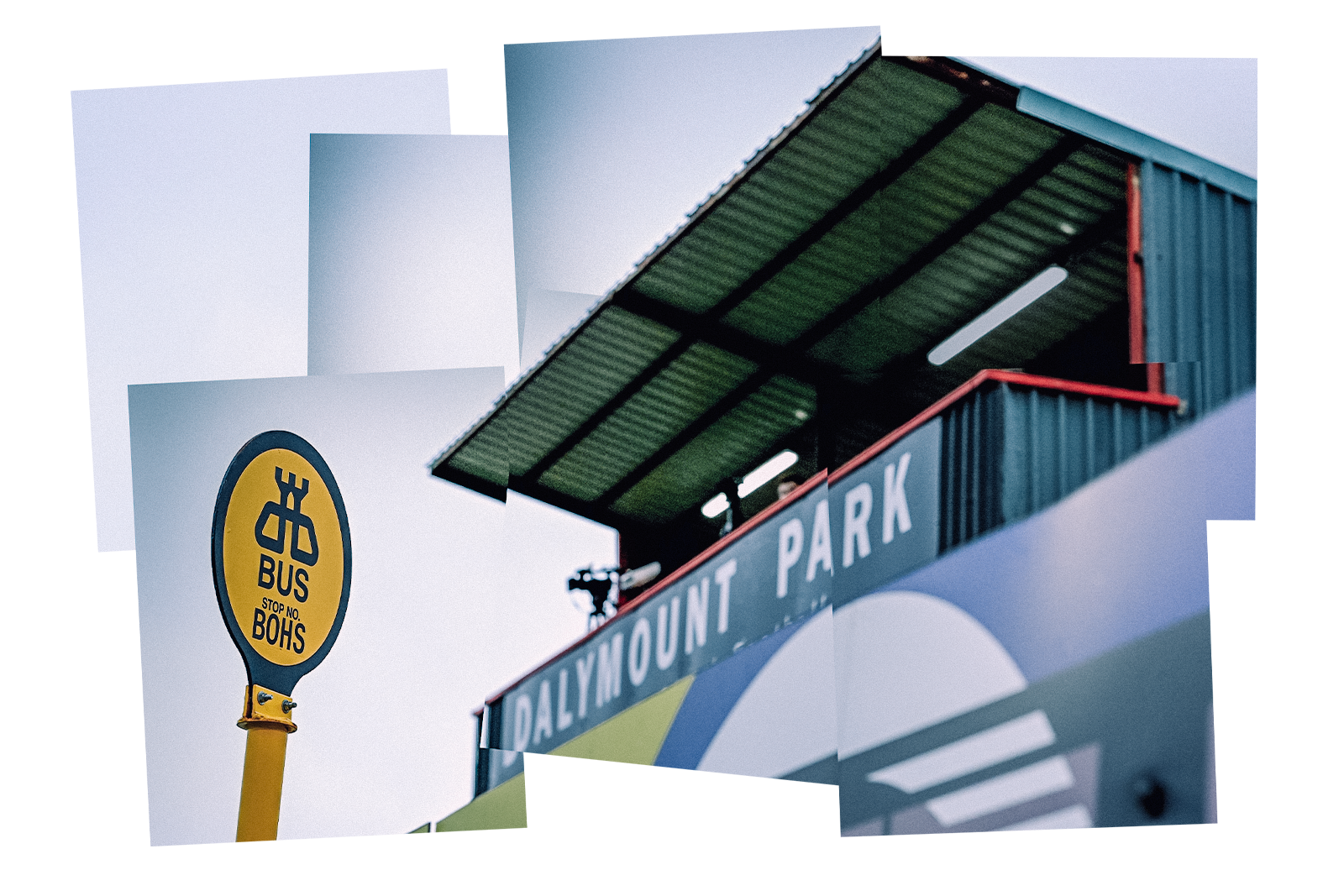
Bohs’ play at Dalymount Park (Brendan Moran/Sportsfile via Getty Images)
“From the late 1940s, apart from a few occasional spikes, we were pretty much lower half and have finished bottom. There was no second division then so we’ve never been relegated.”
Twelve months after agreeing to pay players on a semi-professional level, Bohs won the FAI Cup for the first time in 35 years, then again in 1975-76, plus, quickly, two League of Ireland titles. They met Rangers in the European Cup and Newcastle United in the UEFA Cup.
Yet, they lost money as league attendance dropped by 70 per cent; unemployment, poor facilities and the attraction of English football were factors in that.
By the start of the 21st century, Bohs were winning again — four titles and various cups in an eight-year period — and with Ireland’s economic fairytale, the ‘Celtic Tiger’, bending logic, they agreed to sell Dalymount for €60million (now £51.7m; $64.5m). Money was borrowed on that understanding.
“What we had sold to our fanbase — a very Celtic Tiger thing, an ego thing — was that we were going to win everything,” says Bohs’ chief operating officer, Daniel Lambert. “But that wasn’t based on reality. It was based on large losses and debt.”
When the Celtic Tiger dissolved, Bohemians, like so many other businesses, were exposed. Dalymount’s sale fell through. “In 2011-12,” Lambert says, “the club cut its first-team budget by 93 per cent, from €1.3m to about €100,000 in one season.”

The Bohs’ manager Alan Reynolds (Brendan Moran/Sportsfile via Getty Images)
Economic implosion demanded a rethink. In 1969, when the decision to alter amateur status was taken, Bohs had fewer than 400 members; today it has 3,000. Income is up, games are sold out and the club’s shirt sales have become a phenomenon. The reason, according to Lambert, is relevance. Bohemians’ aim is to be “a force for good”. In that sense: more than a club.
Sitting beside a portrait of Liam Whelan in a cafe he owns around the corner, Lambert talks about Bohemians ancient and modern.
“The biggest change in the last 30 years in global football has been the privatisation and commercialisation of the game,” he says. “Our membership has rejected that model.
“If you take that as the club’s natural structure, which it is, then being a force for good is a natural extension of that. We’re far more relevant to people.”
This means diligent community work and a return to the original ethos of bohemia; of thinking and behaving differently. The club has become known for innovative kits that have been pro-refugee or pro-trade union or have featured musicians such as Bob Marley, who played his only Irish gig at Dalymount in 1980. Shirt sales are “approaching half our turnover”.

The Bob Marley mural (Ramsey Cardy/Sportsfile via Getty Images)
Next Wednesday — Nakba Day — Dalymount will host Bohemians Women against the Palestinian Women’s team. There is a ‘Visit Palestine’ hoarding beside the pitch, paid for by a local company. It is to “make people think”, says Lambert, who compares the club to its Celtic Tiger days. “We’re far more a club that brings people in — for a ton of different reasons, a lot of them sport.
“We’ve got 40 grassroots teams, seven academy teams, women’s teams, an amputee team — we didn’t have any of those 10 years ago.
“As well as that, we do a lot of social good and it’s made our club stronger. Our membership is 10 times higher than its historical average. Our merchandising income is 2,500 times higher. On every measure, including income, our club is a bigger entity than it was. We feel that is due to a broadening of what the club is while being true to what it was set up as.”
Bohemians attract ‘hipster’ mockery, but they also attract investment. Should Brighton ever sell Evan Ferguson, more revenue will come via a chunky sell-on percentage. Ferguson made his Bohemians debut at 14. His father, Barry, played for both Bohs and Rovers.

Outside Dalymount Park (Stephen Marken/Sportsfile via Getty Images)
“We’ve made a cash profit 10 years in a row,” Lambert says. “Our turnover in 2014 would have been around €1million. It’s now €4m. We would have had debts of €6.3m in 2014. We now have €2m on reserve. We’ve bought a 100-year lease on an 11-acre football site for a training ground and planning permission has been granted for a stadium redevelopment.
“This is the longest period we haven’t won anything — since 2009 — but paradoxically our membership has grown from 400 to 3,000. There’s a waiting list.
“Right now, the club has never been more secure financially. Having said that, in the league, it’s unlikely we’ll win it now or in the next two or three seasons, because of the private ownership model that’s become dominant. The success of Manchester United or Chelsea or privately owned Irish clubs is dependent on the losses the owners are prepared to take. You get the odd exception, but if an owner in Ireland next year says they’re willing to lose €5million, they’ll win the league.
“Our success will be related to the number of ordinary people willing to put money in. So it’s the polar opposite.
“Shamrock Rovers are the most successful club in terms of trophies and there’s the Northside-Southside elements. But, for me now, the way the clubs position themselves is very different. I like that we market ourselves differently. Both are clear who they are.”

Bohemians’ Dayle Rooney (Stephen McCarthy/Sportsfile via Getty Images)
Old and new. At number 5 St Peter’s Road, a street beside Dalymount Park, the brown plaque announces this as James Joyce’s family home from 1902-04. Both joyous and depressing is that Joyce would probably recognise quite a lot of old Pisser Dignam’s Field.
Over the decades, Dalymount Park became a personality in its own right, ‘the Home of Irish Football’ as signs still declare, with alleyway entrances akin to Luton’s Kenilworth Road. The great football architect Archibald Leitch arrived in 1928 to add his imprint. Cup finals and European games were played here, Republic of Ireland internationals until 1990. They squeezed almost 50,000 in a few times.
But it has been a dilapidated presence for years, its terraces with Leitch’s barriers unused. So when we say games are ‘sold out’, the capacity is 4,500.
It was 4,429 last Friday with Rovers allocated only 450 tickets and it would be an exaggeration to say the occasion consumed the city. Many cynics here would argue Dublin’s two biggest clubs are Manchester United and Liverpool.
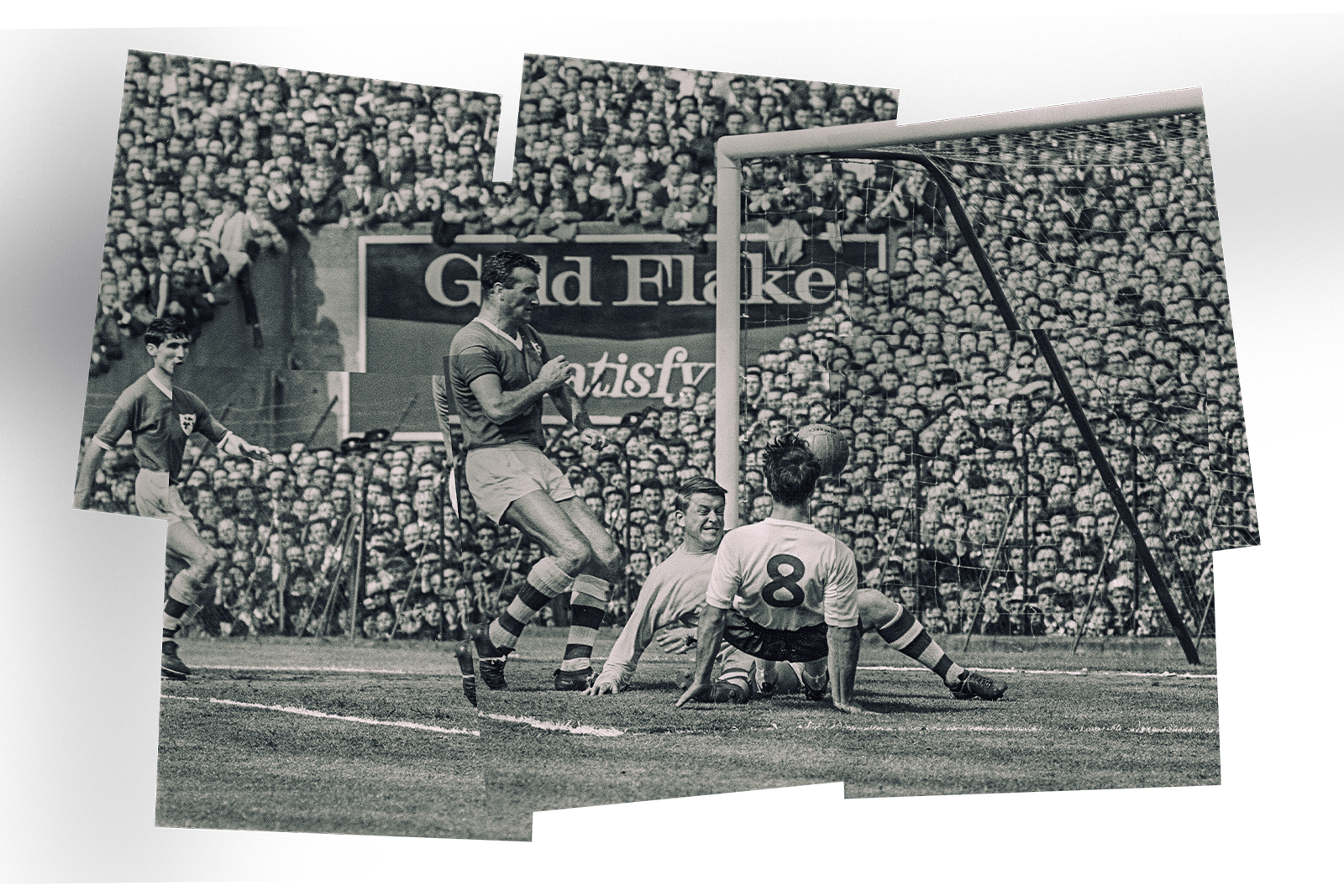
The Republic of Ireland take on England at Dalymount Park in 1964 (Peter Sheppard/Mirrorpix/Getty Images)
But in February, Bohs gained planning permission to demolish and rebuild Dalymount as a modern 8,000-capacity stadium. Season 2027 could see the Dublin derby in a new era.
It needs it. As Bradley says: “The facilities aren’t good enough, let’s not kid ourselves.”
Yet the attendance was not wholly representative of where Bohs, Rovers or indeed the league is in 2024. As perceptions change, audiences are getting bigger, younger, more female. Ticket demand often outstrips supply. There were 44,000 at last November’s Cup final at Lansdowne Road, which Bohs lost. Without prompting, both Fenlon and Bradley mention a Bohs-Rovers derby at Lansdowne. “I think it’d be brilliant,” Fenlon says.
Old and new. Half an hour before kick-off, they are playing The Night by Frankie Valli & The Four Seasons, Northern soul from New Jersey for northern souls in Dublin 7. And in this globalised world, Aboubacar Keita walks along and starts talking about his first club, Columbus Crew, and their derby with FC Cincinnati.
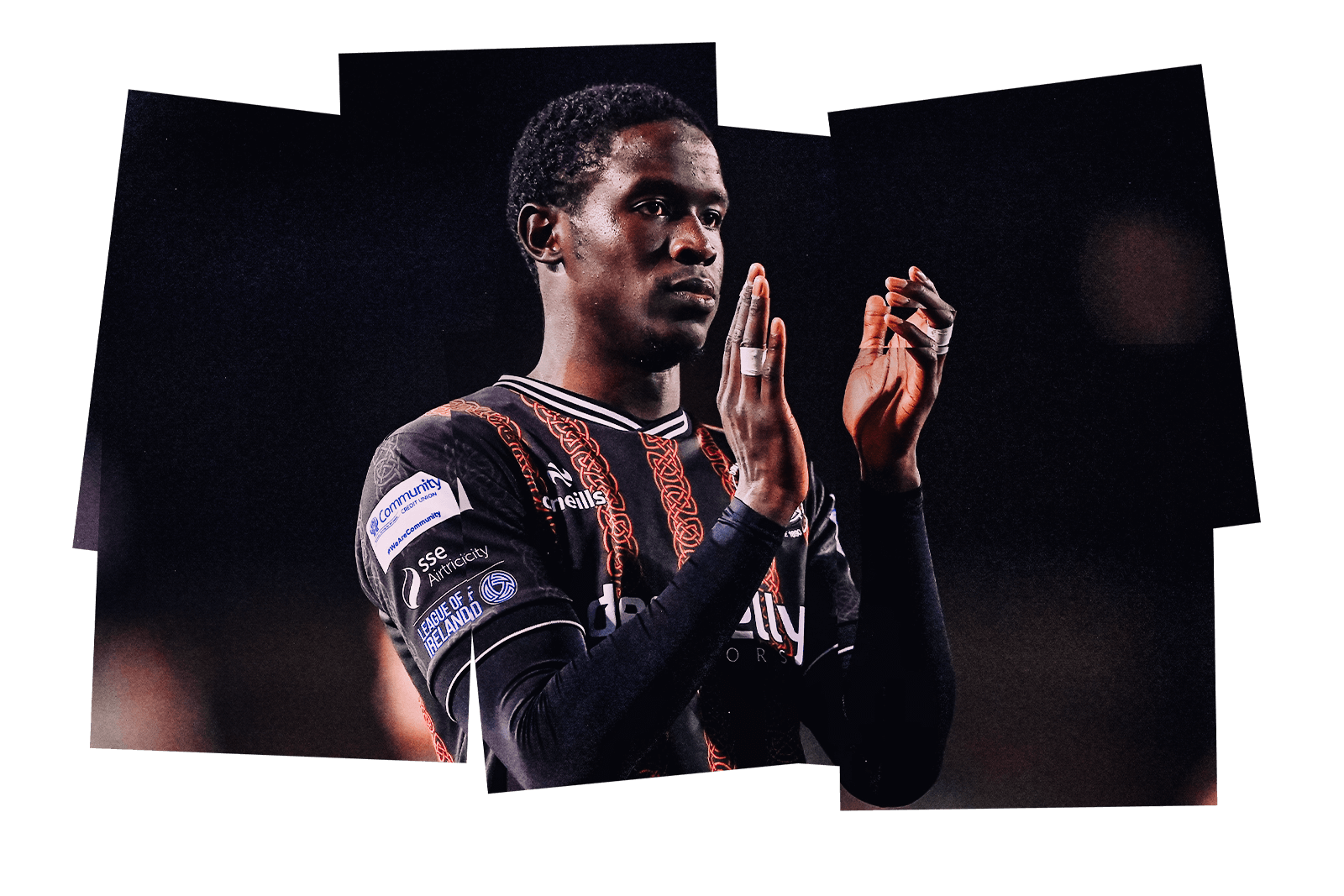
Aboubacar Keita applauds fans after the derby (Stephen McCarthy/Sportsfile via Getty Images)
Keita, 24, a former USMNT under-20 international, arrived on loan at Bohemians from Colorado Rapids the same February day Luke Matheson came from Bolton Wanderers and Jevon Mills from Hull City.
How does Keita describe Bohemians and the League of Ireland when he calls home?
“It’s different,” he smiles. “The facilities are not MLS, but it’s professional and, once you’re part of it, you know more. I feel the league is underrated and I feel blessed to be a part of such an historic club. You learn, you adjust.
“It’s different, but different in a good way.”
Bohs-Rovers, the Dublin derby — they might take that.
(Photos: Getty Images; design: Eamonn Dalton)
Read the full article here


